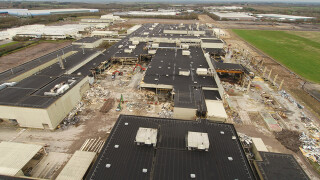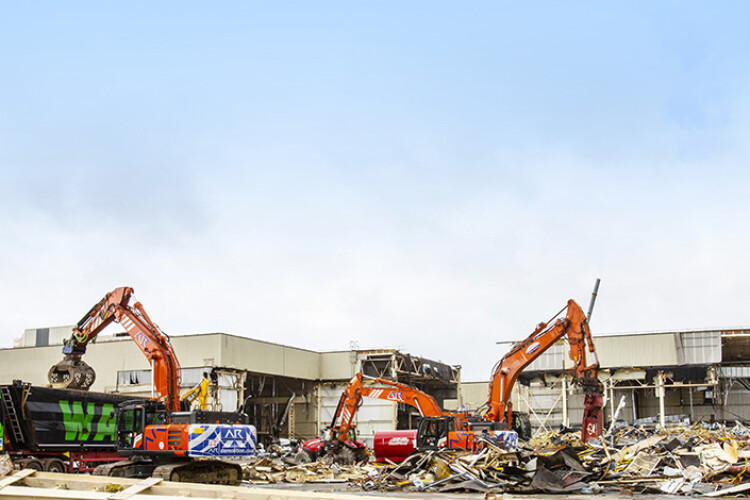The Wiltshire town of Swindon is famous for its place in railway history, being home to the Great Western Railway and Isambard Kingdom Brunel’s railway engineering works.
But the nearby village of South Marston also has a unique industrial heritage, albeit of a more recent variety. Early in the second World War, aircraft manufacturer Phillips & Powis built a factory and airfield outside the village to build the Miles Master trainer for the RAF.
Although an expedient wartime measure, this facility remained in operation for decades afterwards. Short Brothers assembled its Stirling bomber there; Vickers-Armstrong Supermarine also produced warplanes – including the legendary Spitfire – on the site.

Vickers continued to produce aerospace equipment on the site right up until the 1980s when it became subsumed into what is now BAE Systems and the factory closed.
But that was not the end of South Marston’s industrial history. Because for the next three decades, from the late 1980s right up until 2021, the site became a symbol of a new chapter in the UK’s automotive industry: the Japanese had arrived.
The Honda factory, a familiar sight to all regular users of the nearby M4 motorway, kept the site running and was a major employer in the Swindon area until a combination of Brexit and the lifting of EU tariffs on car imports from Japan rendered Honda’s UK factory redundant.
Now the 370-acre site is entering its third industrial incarnation. Its new owner is international industrial real estate developer Panattoni, which plans to demolish the Honda factory and replace it with an industrial park in a project valued at around £900m.
The scheme envisages a new cluster of 11 “net-zero emission” buildings with a combined 7.2 million square feet of industrial space for logistics, manufacturing and data centre use. Panattoni claims the project will create 7,000 jobs for people in Swindon and the surrounding area and a further 9,000 indirect jobs in the supply chain over the next 10 years.
Contractor Winvic – a specialist in industrial warehouse construction – secured the main contract for the first phase of the scheme in January and work started on site in February.
Winvic’s remit ranges from site-wide contamination investigations and demolition of the four main factory buildings (a research & development building, an engine plant and two car plants) and 12 ancillary buildings. The actual demolition work has been subcontracted to Warwickshire-based AR Demolition.
In addition to the demolition work, there is the diversion of services – primarily a foul rising main carrying the sewer from a neighbouring residential development and the reinstatement of the Marston Brook, a natural watercourse that has flowed unseen through a culvert under the Honda factory for the past three decades.
The project also involves about a million cubic metres of muckshifting to level and reprofile the site.

Expectations for the redevelopment are high. This is one of the biggest brownfield sites in the UK and, following the departure of Honda in the wake of Brexit, a symbol of economic recovery for the UK. Such is the importance attached to the project that in early March prime minister Rishi Sunak visited the site to officially launch the redevelopment project.
“What we’re able to celebrate today is one of the largest investments in the south [on] one of the largest development sites in the south,” said Sunak.
Overseeing the work for Winvic is project manager Richard Reid, a man already familiar with the site, having worked as a freelance civil engineer on the second phase of Honda’s redevelopment of the site in the early 1990s.
Reid returned to the site three years ago as part of the team undertaking feasibility for Panattoni prior to Honda’s handover of the site. Also on that team was Mike Henderson, managing director of AR Demolition.
“We were introduced to Panattoni as the preferred demolition partner during the ECI [early contractor involvement] stage and we assisted Panattoni on an advisory and consultancy basis with their due diligence ahead of the site handover,” says Henderson.
This phase involved working with all parties – including Honda – to establish the required decommissioning standards. “We were able to assist Honda in identifying areas which could be removed from the decommissioning such as the de-risk of chimney stacks and the asbestos removal which would be better placed and more economical in the demolition phase instead,” explains Henderson.
“This provided overall benefits for the land purchase and project as a whole, as we all collaborated to ensure a thoroughly integrated approach to the decommissioning and pre-construction phases of this project.”
Environmental expectations are high. Not only will the new industrial units meet net-zero specifications, but also the demolition of the existing buildings is prioritising recycling and reuse of materials from the Honda factory.
In total, an estimated 30,000 tonnes of steel and 150,000m3 of concrete and tarmac will be processed. All of the concrete will be reused on site, says Winvic’s construction manager Jake Davis. “All the concrete is being recycled on site. We’re reducing it to 6F2 [hardcore up to about 75mm] for hard-standing, sub-base and fill for retaining walls, type 1 for general fill and gravel for drainage,” says Davis. “We’ll be using 100% of it”.
Some of the tarmac arisings will also be reused; the site team is currently exploring options for re-blending a proportion of it into new asphalt mixes.

Scrap metal has always provided demolition contractors with an important revenue stream – which can be substantial when scrap prices are high. “We’re the bin-men of the construction industry,” jokes Henderson. But very little of the steelwork from this site is going for scrap.
The aim is that the steelwork will be reused – not just recycled. “We’re aiming for a high percentage of reuse,” says Henderson. Hence intact structural steel components are being removed using high-reach excavators and then cut into sections by hand at ground level.
“The steel beams and columns will go back into the UK market for use on other projects; they won’t be reused here,” continues Henderson. “The reuse of existing steelwork is a very recent development and we’re not quite there yet; but Winvic and Panattoni are really pushing hard for it on this project.”
Removing the steelwork is a painstaking process and AR Demolition is using its new Hitachi-based Kiesel high-reach excavators with a special crane attachment to lift the beams to the ground (see box, below).
According to Henderson, some of the steel columns in the old Honda buildings are significantly heavier than would normally be encountered in buildings of this type. They typically measure 480mm x 420mm with an 80mm-thick flange and are approximately 18m long. “The height is approximate as they are fixed in place and go through a mezzanine floor,” he says.
The reason for this apparent over-engineering is Honda’s standardised construction specifications, used in all its buildings in all territories. And because Japan is a seismic hotspot, that means that all of its buildings are designed to be earthquake-proof, says Henderson.
The concrete hard-standing is not such a challenge. “The slabs are coming up quite easily – they’re not massive: about 200mm thick,” says Henderson.
However, there are a couple of deep concrete pits in the former main car production area. These housed the massive hydraulic presses used to produce body panels and comprise heavily reinforced concrete to a depth of about 7.5m with rebar up to 50mm thick.


Due to the size of the site and the number of buildings to demolish, there’s a lot of light metalwork, such as cladding panels, to remove. This is being packaged up on site using a baling machine supplied by one of AR Demolition’s waste-handling partners.
“Usually this process would be completed offsite. However, given the size of the site and volume of items such as cladding panels, it is more appropriate and sustainable to have a site-based baler,” says Henderson.
“This removes the need for secondary offsite processing and allows us to bale larger items more easily and efficiently.”
At the time of writing, the site team was in week seven of the 44-week programme. “We’re currently about 10% done and slightly ahead of programme,” says Henderson. “We had a good head start thanks to the early contractor involvement.”
Not surprisingly, the site is currently a hive of activity: AR will have between 26 and 55 people on site at any one time.
The work is being divided into two phases, the first leading to a 16-week milestone clearing the northern part of the site. “When that’s done, we will follow up with earthworks,” says Winvic project manager Richard Reid.

Most of the site investigation (SI) work was carried out during the decommissioning phase, while Honda was still in possession. “BWB has already done a substantial SI for Panattoni as part of their due diligence,” explains Reid. Part of that exercise identified potential contamination hot-spots that were inaccessible until demolition had commence begun.
Hence geotechnical consultant BWB Engineering is now completing a four-week SI over these locations.
“It’s difficult to do a thorough site investigation while the buildings are still standing,” says Davis, “but from what we can gather so far, all the environmental measures Honda put in place have stood the test of time.”
So far the demolition team has yet to encounter any unforeseen snags. “We’re well into the demolition now and expect to complete it just before Christmas,” says Henderson.
“The main challenge, from the demolition point of view, is the big pits where the hydraulic presses were. But they’re actually coming out quite easily. Otherwise, the challenge is simply the sheer size of the project. It’s a vast site.”
THE DEMOLITION FLEET
As befits one of the biggest demolition projects in the UK right now, AR Demolition has mobilised a significant fleet of equipment on the old Honda site.
In the early mobilisation phases AR Demolition supplemented its own equipment with some AR-branded hired machines, says managing director Mike Henderson, but now the fleet is largely made up of AR machines plus a ‘significant’ amount of equipment bought specifically for this job.
The company currently has 30 demolition excavators, ranging from 20 tonnes to 100 tonnes, working on the site. Many of them are Hitachi machines, including ZX890, ZX530 and ZX350 excavators.
“The fleet also includes our two flagship machines: Hitachi-based Kiesel long-reach excavators with interchangeable arms,” says Henderson.
These machines are custom-built Hitachi KMC400 and KMC600 excavators with quick-release attachments and arms supplied by Kiesel, the German engineering specialist.
The larger KMC600 has an 18m-long crane boom that is being used to remove rooftop plant, such as chillers, in one piece. “This helps us to be more efficient, greener and safer on site,” says Henderson.
The quick-hitch mechanism allows the machine operator to switch between the excavator arm and crane boom without even having to leave the cab – a UK first, according to Henderson.

While the demolition excavators are the more visible resource on site, just as important – if not more so – are the end-of-boom attachments.
“For this project there is significant investment in a range of new of shears, grab attachments and associated quick hitches for use on site,” says Henderson.
“These includes a mixture of Labounty and Genesis shears from three to seven tonnes per attachment. These are the items that carry out the real work.”
STREAMS AND SEWERS
Part of Winvic’s contract requires the diversion of the foul rising main that crosses the site and the reinstatement of the Marston Brook, which currently runs beneath the site in a concrete culvert.
“The Marston Brook is an Environment Agency watercourse and we are employed to ‘deculvertise’ it,” says Winvic project manager Richard Reid. The restored stream will now run on the surface through a landscaped green corridor to improve the public realm and contribute to the project’s biodiversity net gain.
The sewer carries surface water from a housing estate to the west of the site. “We have to divert this because its present route is right under the units we’re developing. We’d be building right on top so, instead, we’re diverting it so that it runs parallel to the new road infrastructure.
“It also crosses the Marston Brook at one point so we have to lower it so that it runs under the watercourse,” adds Reid.
All the electrical infrastructure for the Honda plant has been stripped out but Panattoni is keeping the existing 45MVA substation which is “quite adequate” for the new development, he says.
“The nice thing is that all the utilities are already there – we can just reuse them too,” he adds.
Tablet users
Rishi Sunak lends a hand
Got a story? Email news@theconstructionindex.co.uk



